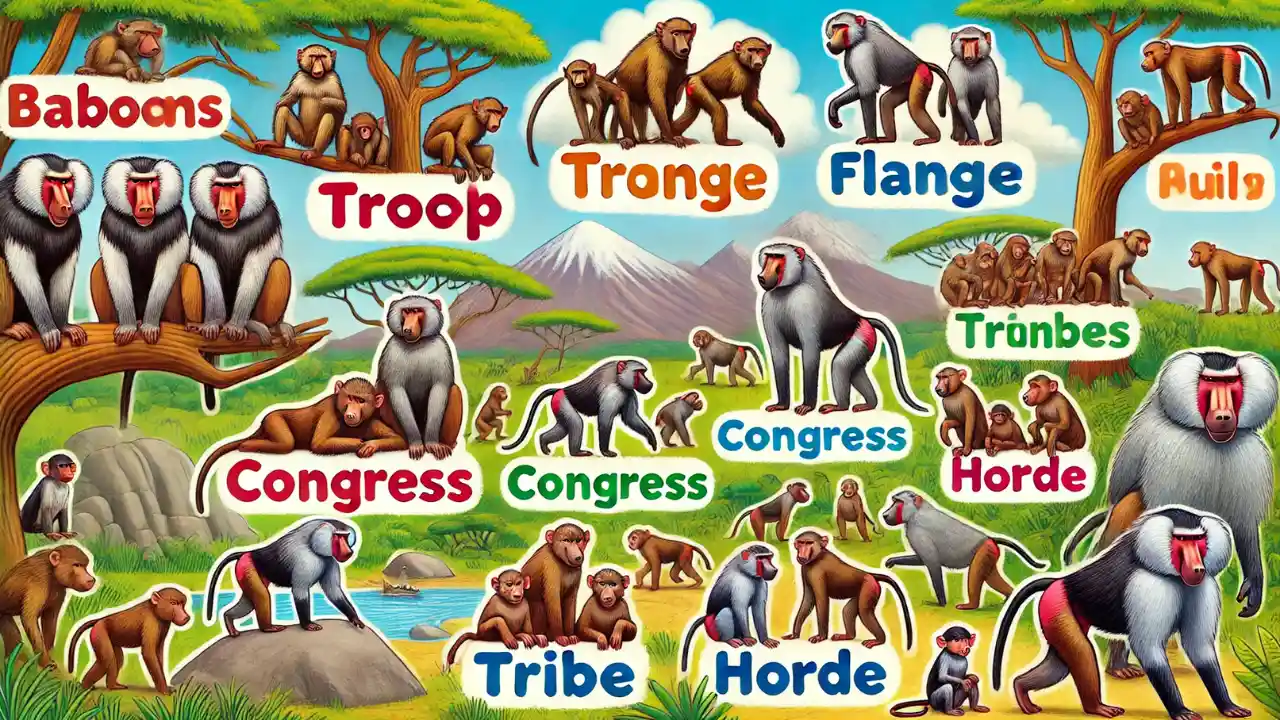Baboons are lively, intelligent, and highly social primates that often live in large groups. Just like other animals, baboons have their own special collective nouns to describe these gatherings. These terms highlight the unique and fascinating behavior of baboons. Let us explore the collective nouns for baboons and how to use them.
Collective Noun for Baboons in Table
Here are the most common collective nouns used for groups of baboons:
| Collective Noun | Meaning |
|---|---|
| Troop | A group of baboons living and traveling together |
| Flange | A term for a group of baboons, especially in humorous contexts |
| Congress | A large group of baboons behaving like a council or assembly |
| Tribe | Baboons living and cooperating in a close-knit group |
| Horde | A noisy or chaotic group of baboons |
Detailed Explanations and Examples for Baboons
1. Troop
The most widely used term for a group of baboons is “troop.” This describes their close social bonds and coordinated activities.
- Example 1: A troop of baboons marched across the savanna in search of food.
- Example 2: The troop of baboons rested in the shade of the acacia trees during midday.
- Example 3: We observed a troop of baboons grooming each other near the riverbank.
2. Flange
Flange is a less common but amusing term used for a group of baboons, often in a lighthearted context.
- Example 1: A flange of baboons entertained visitors with their playful antics at the safari park.
- Example 2: The documentary featured a flange of baboons interacting in a jungle clearing.
- Example 3: We laughed as the flange of baboons climbed trees and chased each other.
3. Congress
This term describes a large gathering of baboons, often behaving like a council or assembly.
- Example 1: A congress of baboons gathered noisily around the waterhole.
- Example 2: The congress of baboons seemed to be discussing something important as they sat together.
- Example 3: The researchers studied the interactions within the congress of baboons.
4. Tribe
Tribe highlights the cooperative and familial bonds in a group of baboons.
- Example 1: A tribe of baboons worked together to gather fruit from the trees.
- Example 2: The tribe of baboons stayed close, protecting their young from predators.
- Example 3: In the early morning, the tribe of baboons moved through the dense forest together.
5. Horde
When baboons are particularly loud or chaotic, they’re often called a horde.
- Example 1: A horde of baboons descended on the farmer’s field, snatching crops.
- Example 2: The horde of baboons created a ruckus as they fought over a pile of bananas.
- Example 3: Visitors to the park were amazed by the energy of the horde of baboons.
Conclusion
Baboons are social and fascinating animals and their collective nouns like troop, congress and horde capture their personality and behavior. Whether they’re traveling as a troop or causing chaos as a horde, these terms help us appreciate their lively nature. Next time you see a group of baboons, you will have the perfect word to describe their gathering.
